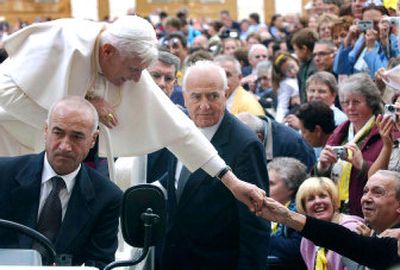Meeting of bishops touches on hot topics

ROME – The opening days of a Vatican meeting of 250 Catholic bishops under the auspices of Pope Benedict XVI has produced relative fireworks, considering the usual staid nature of such get-togethers.
Hot topics emerged from the moment the bishops sat down Monday. Among them were a purported shortage of priests, the debate over letting priests marry, and whether communion should be offered to divorced Catholics or to politicians who support abortion rights.
Detailed daily briefings about the closed sessions gave the issues a public airing unusual by Vatican standards. Such was the crush of headlines that the Vatican responded with a venerable method of control: It limited the information provided to journalists and the public.
Clergy who had been briefing reporters said Wednesday that from now on they would only disclose the topics of discussion, not details, in order to allow the bishops to speak more freely.
Bishops from 118 countries are meeting in Vatican City. Known as a synod, the gathering was formally called to discuss the Eucharist, the central Mass sacrament of bread and wine. However, working papers presented at synods, which take place every two years, cover a wide range of topics.
The prelates sit in a special hall that resembles an amphitheater, as if attending a college lecture. Each is given six minutes speaking time in a daily discussion session. The bishops will make recommendations to the pope at the end of the three-week meeting.
The decision to limit public information was reminiscent of a blackout on media coverage imposed by the Vatican nine days in advance of the conclave that elected Benedict pope in the spring. Traditionally, that period is one of openness before the voting cardinals closet themselves to choose a new pope. According to cardinals present at the time, it was Benedict, then known as Cardinal Joseph Ratzinger, who imposed the ban in his role as senior prelate.
The limits on synod information were laid down a day after one speaker, U.S. Archbishop William Levada, was quoted as saying the bishops ought to discuss banning communion for Catholic politicians who back abortion rights. The issue “has caused some divisions among the people in the church,” Levada said.
During last year’s U.S. presidential campaign, at least one American bishop said he would refuse to give communion to Democratic candidate Sen. John Kerry because of his support of abortion rights. Levada is Benedict’s successor as head of the Congregation for the Doctrine of the Faith, the Vatican office that enforces orthodoxy.
A day before Levada’s remarks, the briefers aired a debate over priestly celibacy.
In the past, Benedict has displayed antipathy to such give-and-take in public and has criticized theologians for discussing all sides of issues on the grounds that open debate confuses parishioners.
A representative from an Eastern Rite church, one of the bodies of Orthodox Christianity that recognizes Vatican authority, suggested that Catholic rules requiring celibacy among priests had no theological grounds.
Bishop Luis Antonio Tagle of the Philippines said the synod had to squarely confront a priest shortage so as to provide congregations with proper services.